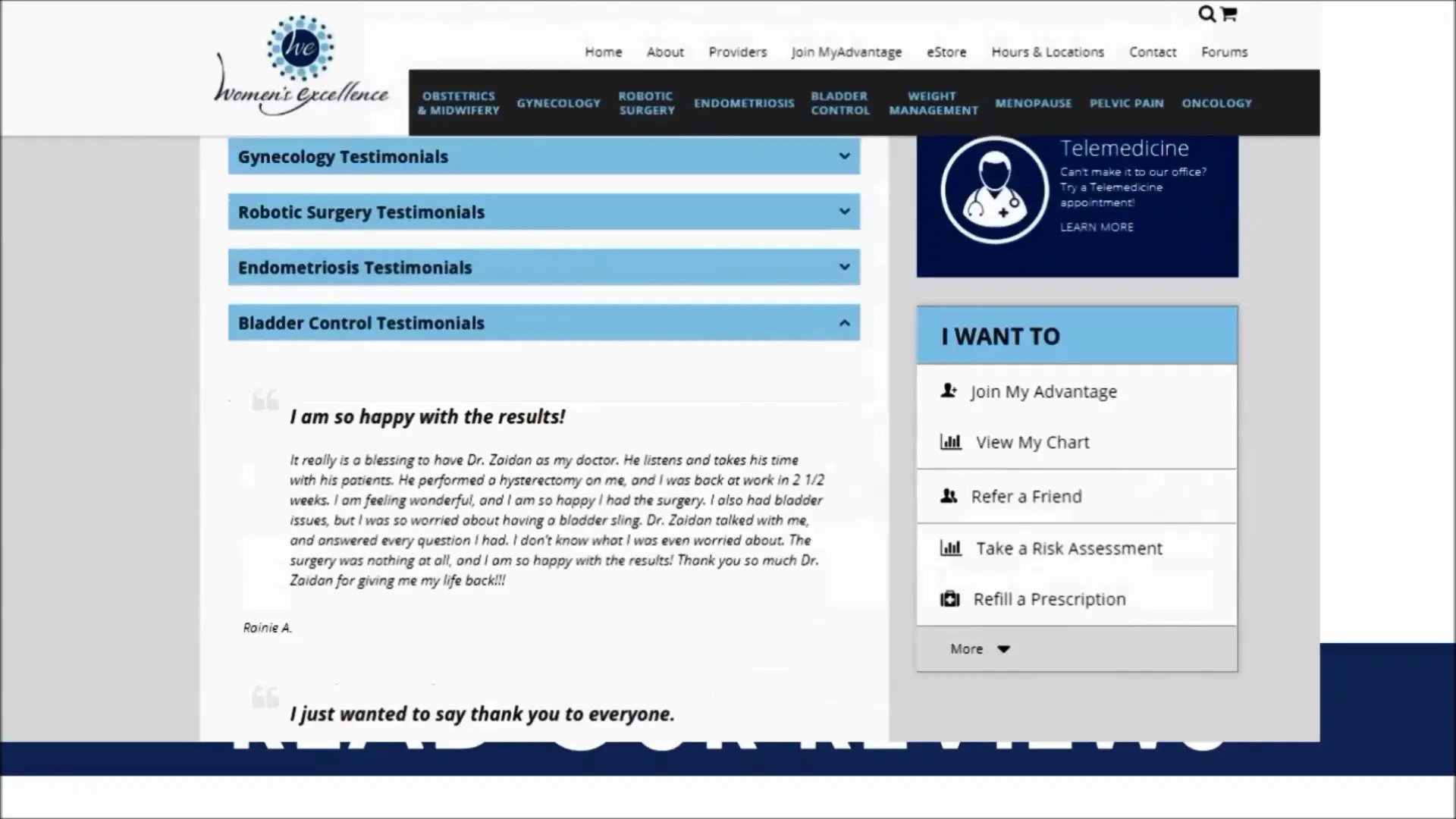Services and Symptoms
Bladder Care and Complete Urologic Workups
We offer complete and comprehensive urologic workups in an office setting. The specialists at Women’s Excellence in Bladder Control want to ensure that your full evaluation is done conveniently and discreetly in our center, which is dedicated to bladder control issues. We offer cystoscopy, urodynamic bladder testing, potassium sensitivity testing and ultrasonography in the office.
Entercoele Repair
An enterocoele is suspected when there is a loss of posterior vaginal wall support or upper vaginal bulging. At Women’s Excellence in Bladder Control, we evaluate everyone with prolapse in a comprehensive manner in order to ensure we have detected this major problem. A thorough bidigital examination of the rectovaginal septum is performed on every patient in order to detect and prevent this from causing pressure. One a thorough diagnosis has been made, the specialists at Women’s Excellence in Bladder Control begin to exclude all other causes of pelvic pressure and will ensure there are no bladder issues, other pelvic floor abnormalities, or pelvic masses.
Evaluation and Treatment of Vulvodynia (Vulva Pain)
We understand the major life altering disorder of vulvodynia. Vulvodynia is defined as excessive pain in the vulvar region and can cause significant physical, sexual, and psychological distress. Vulvar pain can be related to a specific disorder such as infection, inflammation, neoplasm, or neurologic disorders. Vulvodynia refers to vulvar discomfort without an associated secondary cause. The exact cause of vulvodynia in unknown and varies in different patients. The actual diagnosis is often made on the basis of exclusion. We realize that this problem can be very troublesome to any woman and we take the complaint seriously.
Treatment For Women Who Leak Urine When Sneezing Or Coughing
Stress Urinary Incontinence (SUI) is the leakage of urine during activities that increase abdominal pressure such as coughing, sneezing, laughing, or other physical activities. SUI results from the relaxation of vaginal and pelvic support tissues often due to vaginal trauma from childbirth and/or the aging process. Other causes include previous surgery for incontinence and radiation.
How do I know if I have SUI?
Women’s Excellence will go through a comprehensive history and physical exam that can reveal the signs and symptoms of SUI. Urodynamics (link this to the page) testing will evaluate the function of the bladder and urethra. As well as other tests may be ordered to rule out other urinary disorders as well. After evaluating an individual patient, how much their urinary incontinence affects their life, and what it may be caused by, Women’s Excellence can then create a personalized treatment plan.
Treatment To Stop Constant Dribbling Of Urine
Stress Urinary Incontinence can be treated a few different ways, and Women’s Excellence will build a personalized plan for each patient that best suits their needs and symptoms.
- Kegel Exercises help to strengthen the pelvic floor and reduce symptoms of SUI
- Medications can help relieve the symptoms of SUI and may be prescribed depending on your medical history
- For women that have profound pelvic organ prolapse, removable pessaries can be used in the vagina to help suspend a bladder prolapse of uterine prolapse and relieve the symptoms of SUI
- Periurethral Injection is a simple non-surgical procedure that can help eliminate minimal urine leakage
- Periurethral Collagen (Coaptite) is a synthetic bulking agent that can be injected into tissue surrounding the urethra to treat symptoms of urinary dribbling. The bulking material helps keep the urethra closed thereby reducing urinary leakage. This procedure is minimally-invasive and can be done more than one time.
- Minimally invasive surgical procedures to resolve SUI can be done without an overnight hospital stay
Evaluation And Treatment Of Dropped Bladder (Bladder Prolapse)
Women’s Excellence stresses the importance of evaluations of a dropped bladder to help eliminate or avoid urinary retention frequency, pain, and recurring UTIs.
Cystocele: Bladder Prolapse, bladder drops/protrudes into vagina. Symptoms: Overactive Bladder (OAB), urinary retention, urinary incontinence, incomplete emptying of bladder, urinary frequency, urinary urgency, painful intercourse.
Rectocele: Rectal Prolapse, rectum protrudes into vagina, symptoms: constipation, incomplete evacuation of stool.
Pelvic Organ Prolapse: Pelvic organ prolapse occurs when a pelvic organ-such as your bladder-drops (prolapses) from its normal place in your lower belly and pushes against the walls of your vagina. This can happen when the muscles that hold your pelvic organs in place get weak or stretched from childbirth or surgery.Many women will have some kind of pelvic organ prolapse. It can be uncomfortable or painful. But it isn’t usually a big health problem. It doesn’t always get worse. And in some women, it can get better with time.More than one pelvic organ can prolapse at the same time. Organs that can be involved when you have pelvic prolapse include the:
- Bladder (This is the most common kind of pelvic organ prolapse)
- Urethra
- Uterus
- Vagina
- Small bowel
- Rectum
Pelvic organ prolapse is most often linked to strain during childbirth. Normally your pelvic organs are kept in place by the muscles and tissues in your lower belly. During childbirth these muscles can get weak or stretched. If they don’t recover, they can’t support your pelvic organs.
Comprehensive Bladder Function Testing
Pelvic Ultrasound
What is a pelvic ultrasound?
A pelvic ultrasound is a noninvasive diagnostic exam that produces images that are used to assess organs and structures within the female pelvis. A pelvic ultrasound allows quick visualization of the female pelvic organs and structures including the uterus, cervix, vagina, fallopian tubes and ovaries.
Ultrasound uses a transducer that sends out ultrasound waves at a frequency too high to be heard. The ultrasound transducer is placed on the skin, and the ultrasound waves move through the body to the organs and structures within. The sound waves bounce off the organs like an echo and return to the transducer. The transducer processes the reflected waves, which are then converted by a computer into an image of the organs or tissues being examined.
The sound waves travel at different speeds depending on the type of tissue encountered – fastest through bone tissue and slowest through air. The speed at which the sound waves are returned to the transducer, as well as how much of the sound wave returns, is translated by the transducer as different types of tissue.
An ultrasound gel is placed on the transducer and the skin to allow for smooth movement of the transducer over the skin and to eliminate air between the skin and the transducer for the best sound conduction.
Another type of ultrasound is Doppler ultrasound, sometimes called a duplex study, used to show the speed and direction of blood flow in certain pelvic organs. Unlike a standard ultrasound, some sound waves during the Doppler exam are audible.
- Pelvic ultrasound may be performed using one or both of 2 methods:Pelvic Ultrasound
- Transabdominal (through the abdomen). A transducer is placed on the abdomen using the conductive gel
- Transvaginal (through the vagina). A long, thin transducer is covered with the conducting gel and a plastic/latex sheath and is inserted into the vagina
The type of ultrasound procedure performed depends on the reason for the ultrasound. Only one method may be used, or both methods may be needed to provide the information needed for diagnosis or treatment.
Other related procedures that may be used to evaluate problems of the pelvis include hysteroscopy, colposcopy, and laparoscopy.
How do I prepare for a pelvic ultrasound?
EAT/DRINK: Drink a minimum of 24 ounces of clear fluid at least one hour before your appointment. Do not empty your bladder until after the exam.
Generally, no fasting or sedation is required for a pelvic ultrasound, unless the ultrasound is part of another procedure that requires anesthesia.
For a transvaginal ultrasound, you should empty your bladder right before the procedure.
Your doctor will explain the procedure to you and offer you the opportunity to ask any questions that you might have about the procedure.
Based on your medical condition, your doctor may request other specific preparation.
What happens during a pelvic ultrasound?
A pelvic ultrasound may be performed in your doctor’s office, on an outpatient basis, or as part of your stay in a hospital. Procedures may vary depending on your condition and your hospital’s practices.
Generally, a pelvic ultrasound follows this process:
For a transabdominal ultrasound
- You will be asked to remove any clothing, jewelry, or other objects that may interfere with the scan.
- If asked to remove clothing, you will be given a gown to wear.
- You will lie on your back on an examination table.
- A gel-like substance will be applied to your abdomen.
- The transducer will be pressed against the skin and moved around over the area being studied.
- The transducer will be pressed against the skin and moved around over the area being studied.
- If blood flow is being assessed, you may hear a “whoosh, whoosh” sound when the Doppler probe is used.
- Images of structures will be displayed on the computer screen. Images will be recorded on various media for the health care record.
- Once the procedure has been completed, the gel will be removed.
- You may empty your bladder when the procedure is completed.
For a transvaginal ultrasound
- You will be asked to remove any clothing, jewelry, or other objects that may interfere with the scan.
- If asked to remove clothing, you will be given a gown to wear.
- You will lie on an examination table, with your feet and legs supported as for a pelvic examination.
- A long, thin transvaginal transducer will be covered with a plastic or latex sheath and lubricated. The tip of the transducer will be inserted into your vagina. This may be slightly uncomfortable.
- The transducer will be gently turned and angled to bring the areas for study into focus. You may feel mild pressure as the transducer is moved.
- If blood flow is being assessed, you may hear a “whoosh, whoosh” sound when the Doppler probe is used.
- Images of organs and structures will be displayed on the computer screen. Images may be recorded on various media for the health care record.
- Once the procedure has been completed, the transducer will be removed.
Potassium Sensitivity Test
- A potassium sensitivity test (PST) is a simple office procedure performed by a nurse practitioner that will test the bladder for interstitial cystitis/painful bladder syndrome (IC/PBS). IC/PBS is a chronic disease of the bladder that can cause pelvic pain, pressure, or discomfort.
- The procedure is no more uncomfortable than a pap smear, takes less than 5 minutes, and requires no preparation. A tiny plastic catheter is placed into the bladder followed by 2 different solutions that are instilled into the bladder through the catheter one at a time, testing the bladder for IC/PBS.
- If the test is positive and you have a convincing history of urinary symptoms and/or pelvic pain, it is likely that you have IC. At that point, you will be offered an effective treatment regimen that includes an oral medication, bladder treatments and return visits to your physician or nurse practitioner for routine follow-up.
- A negative test does not necessarily mean that you do not have IC. You will return to your physician or nurse practitioner for consultation and you will discuss further diagnostic testing and treatment options.
How do I know if I have IC?
Your doctor will be able to diagnose IC after a thorough history and physical as well as a potassium sensitivity test (PST).
What is a PST?
A potassium sensitivity test (PST) is a simple office procedure performed by a nurse practitioner that will test the bladder for IC. First, a tiny plastic catheter is placed into the bladder. Then, 2 different solutions are instilled into the bladder, testing the bladder for IC. The procedure is no more uncomfortable than a pap smear, takes less than 10 minutes, and requires no preparation.
What if I am positive?
If you have a positive PST and have a convincing history of urinary symptoms, it is likely that you have IC. You will return to the doctor for consultation and be started on an effective treatment regimen that includes an oral medication and bladder treatments.
What if I am negative?
A negative test does not necessarily mean that you do not have IC. You will return to the doctor for consultation and you will discuss further diagnostic testing and treatment options.
Urodynamics
Urodynamic Testing
Some urodynamic tests are relatively simple and can be done in our office.
What is a urodynamics test?
A urodynamics test will allow us to take pressure measurements in your bladder and urethra which provides valuable information about bladder function. It is usually ordered by the doctor if you have reported symptoms of stress urinary incontinence (SUI) or overactive bladder (OAB). Some urodynamic tests are relatively simple and can be done in our office. Other tests require sophisticated instruments to measure the amount of pressure experienced by the bladder and urethra. The actual tests done vary from person to person.
How do I prepare for the test?
Please arrive at the bladder control center on time with a moderately full bladder. Try not to empty your bladder before your appointment. You will be able to resume your normal activities immediately following the test.
What does the test involve?
You will be asked to void on a bedside commode during the test and you will also be catheterized with a small urinary catheter briefly during the measurements – sterile water will be instilled into the bladder for this purpose. A vaginal catheter will also be placed. The test can take 20-45 minutes depending on how quickly you can void and get on and off the procedure table. You must be able to tolerate lying on your back with your legs in stirrups, the very same position required for a pap smear.
For basic urodynamic testing:
You will be instructed to arrive for testing with a full bladder.
While you urinate into a container, the volume of urine and the rate at which the bladder empties are measured.
A thin, flexible tube (catheter) is then inserted into the bladder through the urethra, and the volume of any urine remaining in the bladder is measured (post-void residual, or PVR). A slight burning sensation may occur when the catheter is inserted.
The bladder may be filled with water through the catheter until you have the first urge to urinate. The amount of water in the bladder is measured at this point. Then more water may be added while you resist urinating until involuntary urination occurs.
What do you need to know?
We do Urodynamics to evaluate the best way to treat you. It allows us to know the cause of why your bladder is leaking or has activity that is abnormal. This gives us the ability to treat you the most efficiently with the right procedure and medications, for the right problem.
Urodynamic Bladder Evaluation
We offer urodynamics as an in office procedure which differentiates us from many practices who are forced to refer a patient out to another facility for testing. We also offer the latest technologies with computer generated graphing and pressure monitoring, ensuring that we have the most accurate diagnosis of bladder function or dysfunction possible.
Follow up?
A urine culture will be sent to the lab for analysis. You will be called if a bladder infection is found.
You will be scheduled for follow up appointment with your doctor to review your test results.
Treatment of Interstitial Cystitis
Women’s Excellence offers the following treatments for Interstitial Cystitis depending on the degree of each individual patient’s symptoms, evaluation, and history. Modifying one’s diet to a low-acid/ bladder friendly diet is the first step in controlling symptoms. The second step is oral medications to help relieve symptoms:
Oral medications:
Elmiron (pentosan polysufate sodium) – Currently the only FDA approved oral medication to treat IC. This medication works to supplement the bladder lining and reduce symptoms in 3-6 months time. It is recommended that the medication not be discontinued or symptoms would likely return.
Atarax (hydroxyzine hcl) – A first-generation antihistamine in the same drug family as Benadryl. It works to reduce inflammation by inhibiting mast cell formation in the bladder. It has proven to be very useful for the bothersome nighttime voiding that is characteristic of IC/PBS. It is also an anti-anxiety medication that will help you sleep.
Diet – A low acid, bladder-friendly diet is typically the first step in controlling symptoms.
Bladder instillation therapy – Women’s Excellence offers a simple procedure to treat the pain and inflammation associated with IC quickly. We recommended the instillations twice a week for an initial period of 6 weeks. These treatments are also given to treat future IC flares fast.
Pelvic floor physical therapy – Women’s Excellence refers to a number of pelvic floor physical therapists throughout OaklandCounty. Pelvic floor PT is considered to treat pelvic floor dysfunction that often accompanies IC/PBS. Usually a covered benefit on most insurances.
Treatment For Frequent Urination (Over-Active Bladder)
For more information, please click HERE.
Overactive Bladder Treatment
What is Overactive Bladder (OAB)?
Symptoms of OAB include urinary urgency, frequency, dysuria (painful urination), and nocturia (waking up at night to void). Urge incontinence can also occur with OAB and is characterized by an abrupt and strong desire to void with the inability to delay urination sometimes resulting in incontinence.
Overactive-Bladder
What causes OAB?
OAB is caused by bladder muscle (detrusor) instability, hyperactivity, or hypersensitivity, which may be associated with lower urinary tract problems such as cancer, infection, atrophic vaginitis, or obstruction. OAB can result from central nervous system (CNS) disorders such as stroke, multiple sclerosis (MS), or Parkinson’s disease.
Certain medications can cause OAB as well. However, many cases of OAB result from an unknown cause that results in the inability to suppress bladder muscle contractions.
How do I know if I have OAB?
A comprehensive history and physical exam can reveal key signs and symptoms.
Urodynamics testing to evaluate the function of bladder and urethra.
Potassium Sensitivity Testing (PST) to test for Interstitial Cystitis (IC), a bladder disorder that can mimic OAB, may be indicated.
Other additional diagnostic testing may be ordered to rule out other urinary disorders.
How is OAB treated at Women’s Excellence?
Weight reduction decreases the pressure on the bladder and improves symptoms.
Smoking cessation is recommended because nicotine is a bladder irritant.
Bladder retraining/scheduled voiding is a behavioral technique used to improve bladder capacity and control.
Anticholinergic medications help with the symptoms of OAB and can help prevent accidents.
Neuromodulation (Axonics) is like a “pacemaker” for your bladder to help overactivity with costly medications and side effects. This is perfect for patients who can’t afford or don’t want to take medications on a daily basis.
Treatment for IC – combination therapy consists of oral medications and bladder instillations.
Botox is FDA approved for the bladder. It can dramatically reduce the overactivity of the bladder and is simple and safe. This is an outpatient procedure and can be done in less than 10 minutes.
How is OAB treated at Women’s Excellence?
Weight reduction decreases the pressure on the bladder and improves symptoms.
Smoking cessation is recommended because nicotine is a bladder irritant.
Bladder retraining/scheduled voiding is a behavioral technique used to improve bladder capacity and control.
Anticholinergic medications help with the symptoms of OAB and can help prevent accidents.
Neuromodulation (Interstim) is like a “pacemaker” for your bladder to help overactivity with costly medications and side effects. This is perfect for patients who can’t afford or don’t want to take medications on a daily basis.
Treatment for IC – combination therapy consists of oral medications and bladder instillations.
Botox is FDA approved for the bladder. It can dramatically reduce the overactivity of the bladder and is simple and safe. This is an outpatient procedure and can be done in less than 10 minutes.
What do you need to know?
A full workup for bladder control is necessary. Once this is completed, we are proud to have every option available to help your condition!
What is a PST?
Treatment For Recurrent Urinary Tract Infections
We look at Urinary Tract Infections (UTIs) differently. We not only look to help ones symptoms immediately, but we also look to find out why you have gotten the infection in order to prevent another infection from returning. This is what makes the specialists at Women’s Excellence in Bladder Control different. Our center focuses on why something occurs and targets evaluation and treatment to completely treat the problem. We are focused to solve an issue rather than just handle it. Many recurrent urinary tract infections are not even infections at all but rather bladder wall irritations or deficiencies such as interstitial cystitis. If you have a simple bladder infection or chronic recurrent Urinary Tract Infections (UTIs), our specialists can provide you the right therapy and the right diagnostic work-up.
Urogynecological Care
Unlike urologists, who care for both men and women, we cater only to women. We understand that women want to be as discreet as possible when it comes to incontinence and bladder control problems. This is why we created a non-threatening environment to care for these conditions. Women’s Excellence in Bladder Control is a freestanding office that only deals with bladder issues, it is not attached to another office, waiting room, or other patients who have other problems. This allows us to focus solely on your bladder condition until your problem is resolved.
Procedures
Bladder Instillation Treatments for Interstitial Cystitis/Painful Bladder Syndrome (IC/PBS)
IC/PBS is a chronic, painful bladder syndrome primarily found in women. Common symptoms include urinary urgency, frequency, and pelvic pain. IC/PBS is not caused by bacteria and cannot be treated with antibiotics. IC/PBS is a chronic inflammatory condition of the bladder that is best treated with a combination of medication, lifestyle adjustments, diet, bladder treatments, and pelvic floor physical therapy. For more information, please click HERE.
Botox Treatments for Overactive Bladder
BOTOX is a different treatment option that takes another approach to targeting the source of your overactive bladder: the bladder muscle itself. For more information, please click HERE.
Colporrhaphy-Anterior and Posterior (Treatment of Cystocele/Rectocele)
Pelvic organ prolapse is a disorder in which the pelvic organs loss their overall support within the pelvic cavity. For treatment of pelvic organ prolapse and associated vaginal wall weaknesses, we provide a multitude of different treatment options. Most of these treatment options are minimally invasive in nature and can be done through either vaginal or minimally invasive abdominal surgical incisions. Cystocele and Rectocele conditions, we can usually use vaginal reconstructive procedures which are called anterior Colporrhaphy and posterior Colporrhaphy.
Comprehensive Bladder Function Testing
Entercoele Repair Vaginal and Abdominal Approaches
An Enterocoele is a term used to generally describe abnormal descent of the small bowel in a deep pouch of Douglas. Rarely, patients are born with a congenitally deep pouch of Douglas, secondary to failure of complete fusion of the rectovaginal septum. More commonly a deep pouch of Douglas is acquired secondary to weakened pelvic floor from multiple pregnancies and deliveries,following hysterctomy and also from long standing chronic straining or activities which put significant pressure on the pelvic floor musculature. An enterocoele is suspected when there is a loss of posterior vaginal wall support or upper vaginal bulging. At Women’s Excellence in Bladder Control, we evaluate everyone with prolapse in a comprehensive manner in order to ensure we have detected this major problem.
Cystoscopy
Cystoscopy is a test that allows your doctor to look at the inside of the bladder and the urethra using a thin, lighted instrument called a cystoscope. At Women’s Excellence in Bladder Control, our providers are able to perform this test in the office to visualize any abnormalities such as ulcerations, tumors or congenial anomalies. For more information, please click HERE.
Graft Augmentation Procedure to Strengthen the Pelvic Floor
Our specialists are experts in the latest methods to treat vaginal wall relaxation with the least recovery and the best outcome. With years of experience using graft augmentation approaches to strengthen the repair, we have become leaders in this type of surgical intervention. We can provide strong and lasting repairs without synthetic mesh. Most cases can be repaired using biologic grafts. If possible we avoid synthetic products (mesh).
InterStim Peripheral Nerve Evaluation Test (PNE)
InterStim Therapy for Urinary Control is indicated for the treatment of urinary retention and the symptoms of overactive bladder, including urinary urge incontinence and significant symptoms of urgency-frequency alone or in combination, in patients who have failed or could not tolerate more conservative treatments. The peripheral nerve evaluation (PNE) is a simple office based test to determine if you have a good response with low level testing. If the PNE is successful a permanent convenient implant like a pacemaker will be placed to help control your bladder problems.
Interstim Therapy from Medtronic
We know that overactive bladder, urinary retention issues and general bladder control problems can consume your thoughts-and alter your life. If you’ve tried behavioral modifications and medications without any success, don’t lose hope! Millions of women experience bladder issues at some time. That is why the specialists at Women’s Excellence in Bladder Control use our expertise in sacral nerve stimulation to provide an innovative overactive bladder treatment for our patients who have failed or could not tolerate more conservative treatments. We have an in-office test that can determine if you are a candidate for this therapy. Interstim is FDA approved since 1997, and covered by the majority of insurances, with over 60,000 patients treated nationwide.” If you think Interstim may be an option for you as your symptoms are interrupting your lifestyle, contact us for an appointment. For more information, please click HERE.
Minimally Invasive Surgery
We specialize in the most minimally invasive methods to treat your bladder control problem. It is one of the most important factors in our treatment plan. We only deviate from the least invasive approach when a lesser invasive approach will sacrifice the patients likely outcome. What does that mean to our patients? It means that by being a patient at Women’s Excellence in Bladder Control they will get the most convenient, least recovery approach every time, NOT once in a while. It means that our patients can be confident in our treatment approaches because they are the most current, utilize the latest technology and most of all statistically provide the best outcomes. How can we achieve this? The specialists at Women’s Excellence in Bladder Control are experts in the latest methods to control these disease processes with the least recovery. For more information, please click HERE.
Pelvic Floor Muscle Strengthening and Relaxation
Pelvic Ultrasound
Perineoplasty
Periurethral Injections For Urinary Dribbling (Coaptite)
Potassium Sensitivity Test
Sacrocolpopexy (Full Pelvic Reconstruction)
Stress Urinary Incontinence







